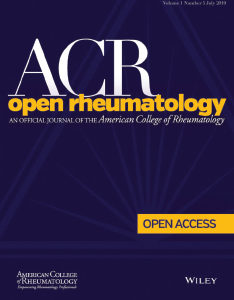
The July issue of ACROR included studies on the tolerability and effectiveness of an adalimumab biosimilar in ankylosing spondylitis.
The ACR’s newest journal, ACR Open Rheumatology (ACROR), launched in 2019 with all articles published in full online. The journal publishes high-quality, rigorously peer-reviewed articles on original investigations in rheumatology research, including basic science, clinical science, epidemiology, health outcomes and education, as well as commentaries and reviews.
Open access is on the rise. A 2017 study estimates approximately 28% of scientific literature was open access and accessible online without a paywall. That’s about 19 million out of 67 million articles, and the proportion of open access articles is growing.1
ACROR joins the ACR’s other journals, Arthritis & Rheumatology (A&R) and Arthritis Care & Research (AC&R), to deliver a broad range of rheumatology research to a wide audience and include creative work, says Edward H. Yelin, PhD, emeritus professor of medicine at the University of California, San Francisco (UCSF), and co-editor-in-chief of ACROR with Patricia P. Katz, PhD, also a professor of medicine at UCSF.
“What’s unique about ACR Open Rheumatology is that we [have] no boundaries. These articles have to pass a rigorous peer review muster, but they can cover a broad range of topics,” says Dr. Yelin. “In Arthritis & Rheumatology, most of the articles published are either clinical trials or basic and translational science. Arthritis Care & Research is more focused on clinical research, including epidemiology and behavioral science.”
Stretch the Envelope

Sergey Nivens / shutterstock.com
Many top medical journals can accept only 10–15% of the articles submitted due to space restrictions, tight publication budgets or other factors, says Dr. Yelin.
“What tends to get through the publication review process when acceptance rates are very low are papers that have unimpeachable methodologies, but they may not always contain the most interesting science or may not stretch the envelope very much,” he says. “We can accept work that may be a little more creative, while still passing through rigorous peer review. Manuscripts that may be interesting to ACROR may have authors who don’t always buy into the accepted wisdom, but they are adhering to stringent standards of quality in their research. There is a potential for this journal to create a place for that creative work that meets high standards of rigor and yet reaches a wide audience.”
Studies that may not qualify for A&R or AC&R based on the assigned priority score “may still report important science,” says Shervin Assassi, MD, MS, chair of the ACR Committee on Journal Publications. Dr. Assassi is an associate professor of rheumatology and clinical immunogenetics at the University of Texas Health Sciences Center, Houston, and McGovern Medical School. “I truly believe ACR Open Rheumatology is addressing an unmet need in our community.”
Rigorous Review
The new journal’s strong, experienced editorial board ensures continuity and high quality in its review process, Dr. Assassi says. ACROR’s deputy editor for clinical science is David I. Daikh, MD, PhD, director of the Rheumatology Fellowship Training Program at UCSF and chief of rheumatology for the San Francisco VA Medical Center. The deputy editor for basic science is Bruce N. Cronstein, MD, the Dr. Paul M. Esserman Professor of Medicine at New York University. ACROR’s social media editor is Paul H. Sufka, MD, a rheumatologist at HealthPartners in Saint Paul, Minn. Dr. Sufka is also social media editor for A&R and AC&R.
“It’s important for the rheumatology community to take advantage of this new resource and publish their manuscripts in this new journal. It meets the expanding needs of our community,” says Dr. Assassi.
Open-Access Benefits
All articles published in ACROR, published by John Wiley & Sons on behalf of the ACR, are accessible online for anyone to read in full, unlike many articles in A&R or AC&R, which are only accessible to read in full one year after publication without an active ACR/ARP membership or a subscription to the journal. ACROR has no paid subscriptions. Any reader may excerpt figures or tables, and share, publish or reuse the content of ACROR articles for non-commercial purposes, without copyright permission.
Authors have two paths to submit articles to ACROR, says Dr. Assassi. They may submit articles directly to the open access journal, or if they have submitted articles to A&R or AC&R that were not accepted but still considered scientifically important by those editors, authors are invited to have their article internally resubmitted to ACROR, he says. In many cases, the review used by the submission to A&R and AC&R can be used for submission to ACROR, speeding the path to publication. To cover the cost of publishing and making articles freely available, authors (or their institutions) are expected to pay a publication fee. More information about these fees is available on the journal’s website.
Creative Work
Dr. Yelin and Dr. Katz, who previously served as co-editors of AC&R, wrote an editorial, “Opening Salvo,” to launch the new journal and explain why it meets an unmet need.2 They compared the very low acceptance rates for the most prestigious journals to low pay lines for National Institutes of Health (NIH) grants. In the editorial, they wrote, “The acceptances you do receive are for good ideas well done—but perhaps not the ones that you feel are most likely to change research or practice, if they could be given a fair hearing by peer reviewers.” ACROR, according to its co-editors, offers a golden opportunity to “push the boundaries a bit by placing the mark at a slightly different point on the rigor-relevance continuum.”
Here is a snapshot of recent studies published in ACROR:
- “Anti-Retinoblastoma Protein Antibodies: A New Specificity in Systemic Lupus Erythematosus Associated with Protection Against Lupus Nephritis,” a study by researchers at Johns Hopkins University that found anti-Rb antibodies, a novel biomarker in lupus, may define a subset of patients protected from kidney involvement and are not associated with antiphospholipid antibodies.3 Anti-retinoblastoma antibodies were present in 15 of 222 lupus patients in the cohort, were strongly negatively associated with proteinuria, renal involvement and anemia, and were positively associated with stroke.
- “Reduced Ovarian Function in Female Rheumatoid Arthritis Patients Trying to Conceive,” a study from The Netherlands, found that women in the cohort with rheumatoid arthritis had lower levels of serum anti‐Müllerian hormone (AMH), a useful proxy for ovarian function.4 AMH levels were lowest in anti-citrullinated protein antibody-positive patients. Preconception AMH levels were not associated with time to pregnancy in the rheumatoid arthritis patients compared with healthy controls.
ACROR articles will be indexed by PubMed after its first 25 articles are published and PubMed approval is received. When indexed in PubMed, the journal will have an impact factor, which will expand visibility for authors, including those from the initial 25 articles.
“We would like to publish more basic science and translational science, but we are seeing submissions across the full range of rheumatology research,” says Dr. Yelin. “We have left the peak, but the snowball has not yet reached its full velocity. But we are on our way.”
Susan Bernstein is a freelance journalist based in Atlanta.
References
- Piwowar H, Priem J, Lariviere V, et al. The state of OA: A large-scale analysis of the prevalence and impact of Open Access articles. PeerJ. 2018 Feb 13;6:e4375.
- Katz P, Yelin E. Opening salvo. ACR Open Rheumatology. 2019 Mar 15;1(1):3.
- Goules A, Li J, Antiochos B, et al. Anti-retinoblastoma protein antibodies: A new specificity in systemic lupus erythematosus associated with protection against lupus nephritis. ACR Open Rheumatology. 2019 Jun 6;1(5):287–291.
- Brouwer J, Dolhain RJEM, Hazes JMW, et al. Reduced ovarian function in female rheumatoid arthritis patients trying to conceive. ACR Open Rheumatology. 2019 Jul 4;1(5):327–335.


